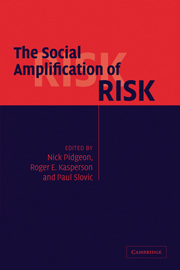Book contents
- Frontmatter
- Contents
- List of figures
- List of tables
- List of contributors
- Acknowledgments
- Introduction
- Part I Conceptual foundations
- 1 The social amplification of risk: assessing fifteen years of research and theory
- 2 The logical structure of the social amplification of risk framework (SARF): Metatheoretical foundations and policy implications
- 3 Social amplification of risk and the layering method
- 4 Institutional failure and the organizational amplification of risks: the need for a closer look
- Part II Risk signals and the mass media
- Part III Public perceptions and social controversy
- Part IV Risk ripples and stigma effects
- Part V Policy and management
- Bibliography
- Index
3 - Social amplification of risk and the layering method
Published online by Cambridge University Press: 06 July 2010
- Frontmatter
- Contents
- List of figures
- List of tables
- List of contributors
- Acknowledgments
- Introduction
- Part I Conceptual foundations
- 1 The social amplification of risk: assessing fifteen years of research and theory
- 2 The logical structure of the social amplification of risk framework (SARF): Metatheoretical foundations and policy implications
- 3 Social amplification of risk and the layering method
- 4 Institutional failure and the organizational amplification of risks: the need for a closer look
- Part II Risk signals and the mass media
- Part III Public perceptions and social controversy
- Part IV Risk ripples and stigma effects
- Part V Policy and management
- Bibliography
- Index
Summary
Risk management has become a dominant concern of public policy and yet the ability of government to anticipate the strength and focus of public concerns remains weak. This has proven to be costly. Rectifying the misunderstandings and assuaging the deep anxieties that surround “scares” and accidents can, and does, cost governments billions of pounds. It is thus vital to understand the genesis and development of such risk impacts. The social amplification of risk framework (SARF) was designed to assist in this endeavor. It aims to facilitate a greater understanding of the social processes that can mediate between a hazard event and its consequences.
The central contention of the framework is that
…Events pertaining to hazards interact with psychological, social, institutional and cultural processes in ways that can heighten or attenuate public perceptions of risk and shape risk behavior. Behavioral patterns in turn generate secondary social or economic consequences. These consequences extend far beyond direct harms to human health or the environment to include significant indirect impacts.
(Renn, Burns, Kasperson et al. 1992, p. 139–140)SARF identifies categories of mediator/moderator that intervene between the risk event and its consequences and suggests a causal and temporal sequence in which they act. Information flows first through various sources and then channels, triggering social stations of amplification, initiating individual stations of amplification, and precipitating behavioral reactions. These also engender ripple effects, resulting in secondary impacts. Within this, the framework identifies two stages.
- Type
- Chapter
- Information
- The Social Amplification of Risk , pp. 80 - 101Publisher: Cambridge University PressPrint publication year: 2003
- 10
- Cited by



